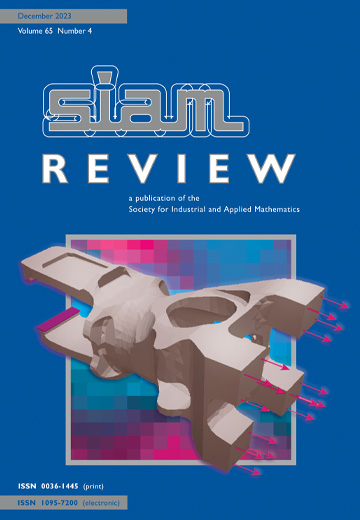Education
IF 10.8
1区 数学
Q1 MATHEMATICS, APPLIED
引用次数: 0
Abstract
SIAM Review, Volume 64, Issue 4, Page 1029-1029, November 2022.This issue of SIAM Review contains two papers in the Education section. The first, “A Generalized Dual Transform: Linear Algebra and Geometry of (Pseudo)Inverting a Matrix,” is presented by L. P. Withers, Jr. For a linear subspace $A$ of a vector space $V$, we may have a nonorthogonal basis of $A$. We could obtain an orthogonal basis (e.g., by the Gram--Schmidt orthogonalization procedure) and the orthogonality helps us to represent each element $b\in A$ as a linear combination of the new basis in an easy way. How should we express $b$ as a linear combination of the original, unorthogonalized vectors? One suggestion is to construct a complementary list of vectors, called a dual list, such that each pair of vectors $a^i,a^j$ on that list are orthogonal and each vector has a length of one. The construction is called the dual transform. Involving the complementary subspace of $A$ in $V$ and orthogonal projections, we obtain again a simple formula for the representation of $b$. Next to generating dual vectors, the Gram--Schmidt orthogonalization procedure exhibits other interesting properties, which lead to a parallel so-called butterfly process for computing the dual transform. The article proceeds to explain how the dual transform is generalized via axioms and how the respective procedures are performed in the general setting. Several examples supplement the discussion. The paper is accessible to advanced undergraduate students with basic knowledge in linear algebra and complex analysis. The second article, “When Randomness Helps in Undersampling,” was written by Roel Snieder and Michael B. Wakin. In our digital era, we use many recordings: music, sounds of nature, and others. Many other signals such as telecommunication, temperature, and air pressure, are recorded for practical and scientific purposes. When signals are stored in computers, they are digitized by collecting and storing values of some functions at discrete times. A straightforward thought on how to accomplish that is to collect values uniformly in time and in all frequency components. However, the measurements might be feasible only for some times or frequencies; otherwise data acquisition or data transmission of a full collection might be too burdensome. When some times or frequencies are left out, it is said that the signal is undersampled. In that case, it is best to choose the times or frequencies to be left out randomly instead of uniformly. The authors focus on the problem of reconstructing a signal in the time domain using undersampled frequency components. The benefits of random undersampling are illustrated with an example of the air pressure recorded at a volcano in Costa Rica, but the authors cite other sources on seismic surveys as well as magnetic resonance imaging where benefits from undersampling are evidenced. The key to understand the phenomena is to analyze the effect of the sampling on the discrete Fourier transform, which allows a discrete-time signal of length $N$ to be represented as a sum of $N$ complex exponential terms. The authors have made the signal processing codes and the data that are used for the article available at https://mines.edu/~mwakin/software. The paper is directed toward undergraduate students in engineering with a mathematical background and interests.
教育
SIAM评论,第64卷,第4期,1029-1029页,2022年11月。本期《SIAM评论》的教育部分有两篇论文。第一个,“广义对偶变换:(伪)逆矩阵的线性代数和几何”,由L. P. Withers, Jr.提出。对于向量空间V的线性子空间A,我们可以有A的非正交基。我们可以得到一个正交基(例如,通过Gram- Schmidt正交过程),并且正交性帮助我们以一种简单的方式将A$中的每个元素$b\表示为新基的线性组合。如何将b表示为原始的,未正交向量的线性组合?一个建议是构造一个向量的互补列表,称为对偶列表,使得列表上的每一对向量$a^i,a^j$是正交的,并且每个向量的长度为1。这种构造称为对偶变换。利用V中A的互补子空间和正交投影,我们得到了b的一个简单表示公式。除了生成对偶向量之外,Gram- Schmidt正交化过程还展示了其他有趣的特性,这导致了计算对偶变换的并行所谓的蝴蝶过程。文章接着解释了如何通过公理推广对偶变换,以及如何在一般情况下执行相应的过程。几个例子补充了讨论。本文适用于具有线性代数和复分析基础知识的高级本科生。第二篇文章是《当随机性有助于采样不足》,作者是Roel snyder和Michael B. Wakin。在我们的数字时代,我们使用许多录音:音乐,自然的声音,和其他。许多其他的信号,如电信、温度和气压,都是为了实用和科学的目的而记录下来的。当信号存储在计算机中时,通过收集和存储离散时间的一些函数值,将信号数字化。关于如何实现这一目标的一个简单的想法是在时间和所有频率分量中均匀地收集值。然而,测量可能只适用于某些时间或频率;否则,完整集合的数据采集或数据传输可能过于繁重。当某些时间或频率被忽略时,我们说信号是欠采样的。在这种情况下,最好随机选择要忽略的时间或频率,而不是均匀地选择。研究了利用欠采样频率分量在时域重构信号的问题。随机欠采样的好处以哥斯达黎加一座火山的气压记录为例进行了说明,但作者引用了地震调查和磁共振成像的其他来源,证明了欠采样的好处。理解这种现象的关键是分析采样对离散傅里叶变换的影响,该变换允许长度为$N$的离散时间信号表示为$N$复指数项的和。作者已经在https://mines.edu/~mwakin/software上提供了用于文章的信号处理代码和数据。这篇论文针对的是有数学背景和兴趣的工科本科生。
本文章由计算机程序翻译,如有差异,请以英文原文为准。
求助全文
约1分钟内获得全文
求助全文
来源期刊

SIAM Review
数学-应用数学
CiteScore
16.90
自引率
0.00%
发文量
50
期刊介绍:
Survey and Review feature papers that provide an integrative and current viewpoint on important topics in applied or computational mathematics and scientific computing. These papers aim to offer a comprehensive perspective on the subject matter.
Research Spotlights publish concise research papers in applied and computational mathematics that are of interest to a wide range of readers in SIAM Review. The papers in this section present innovative ideas that are clearly explained and motivated. They stand out from regular publications in specific SIAM journals due to their accessibility and potential for widespread and long-lasting influence.
 求助内容:
求助内容: 应助结果提醒方式:
应助结果提醒方式:


